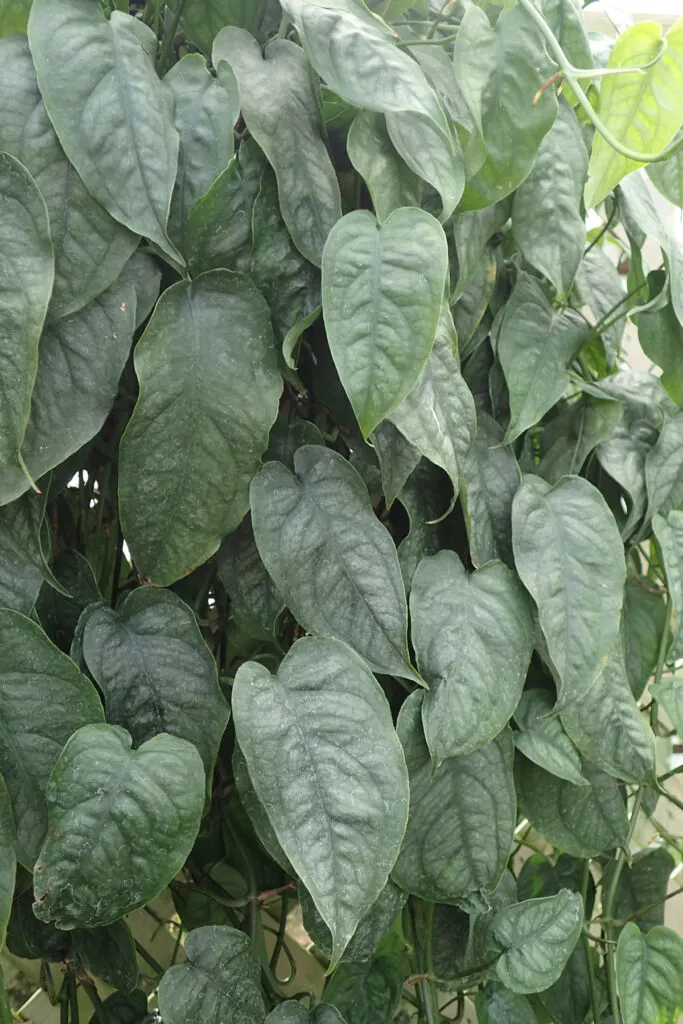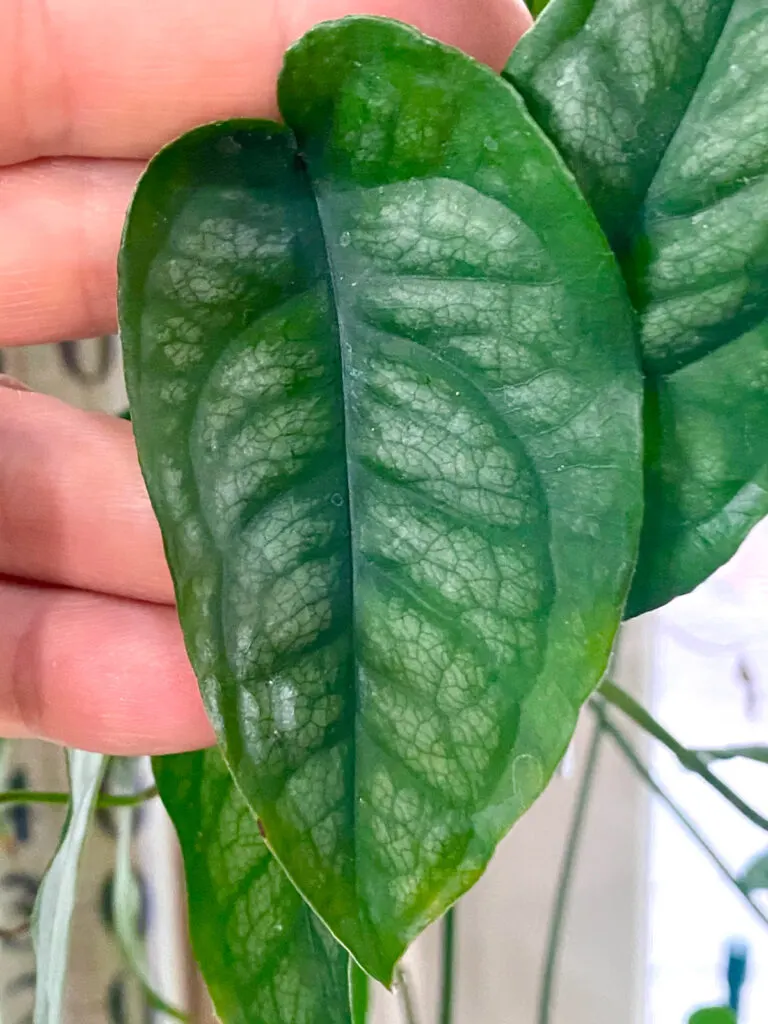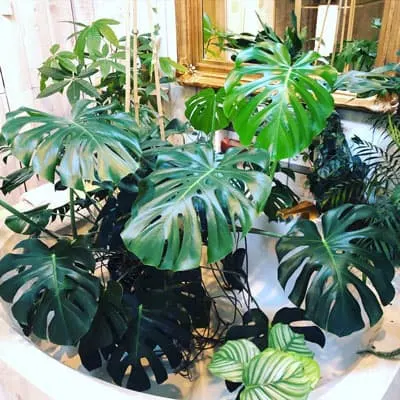Some of the links in this post may be affiliate links.
There are so many beautiful and interesting Monstera species to grow. It’s not all about the ubiquitous Monstera deliciosa! If you’re looking for an easy to grow, less common Monstera species, give Monstera siltepecana a try. Commonly known as Silver Monstera, it’s a versatile AND easy to grow houseplant!
This post will go over critical aspects of care which includes light, watering, humidity, soil and repotting, fertilizing. I also have a brief section with photos on how to propagate.

Table of Contents
Monstera Siltepecana in Nature
Before we go into the care, it always is helpful to understand where and how plants grow in nature, so let’s quickly review that.
This plant is found in Mexico and many parts in Central America. In its juvenile stages, the plants will grow up a tree and have beautiful greyish-green leaves with distinct dark green veins.
As the plants mature, the resulting leaves are completely different from the juvenile form. They turn dark green and develop fenestrations (these are holes in the leaves just like the ones that other Monsteras like deliciosa and adansonii develop).
This species grows as an epiphytic creeper in nature. It starts out at the base of a tree as a juvenile plant and quickly creeps up the tree. And then it goes crazy and lives into adulthood much higher up.

Monstera Siltepecana Care
In the home, this is a very versatile plant so you can grow it in a variety of ways! You can grow this plant in a hanging basket, climbing up a support, or even in a terrarium.
The leaves will stay in their juvenile form if grow in a terrarium or in a hanging basket. They will only develop mature leaves over time if give a sturdy support (and patience indoors).
Sometimes referred to as Philodendron siltepecana, this plant does NOT belong to the Philodendron genus. It belongs to the Monstera genus of plants. Monsteras and Philodendron are related though and both belong in the Aroid or Araceae plant family. Monstera siltepecana is the accepted species according to Kew Gardens.
Given good conditions, I’ve found that this plant grows very quickly in the home! Let’s now get into some details of care.

1. LIGHT
Light is the most important aspect of plant growth, so please be sure to situate your plant in front of a window. These plants like plenty of bright indirect light.
Some direct sunshine is also fine, especially if it is the morning sun that Eastern exposure windows provide.
I have my own plant right in front of a large Eastern exposure window and it is thriving there and growing quickly (almost too quickly).
Take care not to place these plants where it would get too many hours of direct sun. You can always diffuse any windows that are too sunny with sheer curtains or blinds so that your siltepecana leaves don’t burn.
The best thing to do is observe and monitor your plant! Keep an eye on your plant and adjust if needed.

2. WATERING
As a general rule of thumb, the way I water pretty much all my houseplants is the same! Many of the principles of plant houseplant care can be applied to most/all houseplants!
Watering is one of these principles. And here is how I water my siltepecana and any other plant that I have growing in soil.
I wait until the top inch or so of the soil dries out (using my finger to judge this) and then I will water the soil thoroughly until water escapes the drainage hole.
Discard the excess water, and you are done. Simple!
Many people buy moisture meters for their plants, but this really is not necessary! Spare yourself the cost and effort and just use your finger to test the soil moisture. In fact, I wrote a blog post on why moisture meters are dangerous for your plants.
Another note on watering, if your soil gets too dry, this plant will protest with brown leaf tips and yellow leaves. Please keep any eye on the soil moisture.
When I first received my plant, it was really hard to keep it watered in its tiny nursery pot and it dried out VERY quickly. You will see the lower leaves quickly yellowing when this happens.
3. HUMIDITY
If you can have good watering practices and good light, increasing humidity would be a good bonus to help your plant thrive!
My favorite, and easiest way to increase humidity, is simply by using a humidifier. If you need help choosing one, I reviewed the 3 best humidifiers for houseplants.
4. SOIL AND REPOTTING
If your plant came in a small nursery pot, you will probably want to repot it pretty quickly. Don’t get lazy because these plants are not cheap!
One indication that you’ll need to repot are roots coming out of drainage holes. Take a look at mine right before I repotted:

These plants really do grow in a hurry! In this case I had to cut the plastic pot off so I could salvage those beautiful roots.
Once you take the plant out of its pot, you’ll want to loosen the root ball before placing in a larger pot.

As far as the soil mixture that i used, this is a great general recipe for most tropical foliage plants. You can always adjust it to suit your own conditions, but this one works very well for me!
I get my potting ingredients from Amazon and use this recipe:
3 parts Miracle-Gro All Purpose Potting Soil and I add 1 part Perlite. Mix it all up, and you have a beautifully draining potting mix! No need to get fancy.
For my larger Monstera plants, like for my deliciosa, I use a slightly different mixture. Check out my Monstera deliciosa post for those details or come back to it later!
Keep in mind that Miracle-Gro potting mix has fertilizer mixed into it so you won’t have to fertilize for a few months.
5. FERTILIZING
Hands down, the best fertilizer that I’ve used and have switched just about everything to is Dyna-Gro Grow, available on Amazon as well.
Everything has flourished more than normal with this fertilizer. My flowering plants bloom more and everything is healthier and grows more quickly.
It costs a little more than many fertilizers but it is well worth it! Get some Dyna-Gro Grow today and experience the difference for yourself!
I simply mix 1/4 to 1/2 teaspoon per gallon and water everything with it all year except during the winter months.
PROPAGATING MONSTERA SILTEPECANA
Some plants just TELL you how to propagate, and this plant is one of them! Take a look and you’ll see what I mean.

Do you see the roots growing at each node? The node is where the leaf (and the attached petiole) attaches onto the stem or vine.
You can simply make cuttings and place then in water to grow a bit, or you can even place them directly into soil if the root are big enough like the ones pictured above.
Simply make sure that each cutting has one or two leaves, and that you place at least one node under water or under the soil line. It’s as simple as that.
If you want more tips on water propagation, be sure to check out my water propagation blog post for more details!
MONSTERA SILTEPECANA FOLIAGE
When Monstera siltepecana is in its juvenile stage, the foliage is a gorgeous blue-green with silver markings.

As the plant matures, the leaves will look dramatically different and transform. The silver markings will disappear, the leaves are much bigger, and they start to gain fenestrations (holes and slits) in the foliage, similar to Monstera deliciosa and Monstera adansonii.
If you want to achieve mature, adult leaves, the trick is to train your siltepecana on a support such as a moss pole, rough wooden board, or similar support. Even then, you’ll have to wait probably 2-3 years to achieve fenestration in the foliage.
MONSTERA SILTEPECANA PROBLEMS & QUESTIONS
What other Monsteras can I grow at home?
If you want to explore different species of Monstera, be sure not to miss my post on amazing Monstera varieties to add to your collection! There are so many interesting varieties to explore and grow.
When will my siltepecana get fenestrations?
In order to get fenestrations (holes and slits) in the foliage, your siltepecana needs a sturdy support to attach and climb on, and you need to allow for enough time. It generally can take about 2-3 years to see fenestrations. If you have your plant in a hanging basket like I do, the foliage will forever remain in the juvenile state and will never reach maturity.
Why does my siltepecana have brown tips?
Although the traditional wisdom is low humidity (which can be the case), brown tips are most often caused by your potting mix going too dry for too long. If you can maintain consistent moisture levels and avoiding extremes (too dry or too wet), brown tips should not be a major problem at all.
Is Monstera siltepecana fast growing?
In my experience, this plant is extremely fast growing. My own plant is in a hanging basket and every month or two, I’m winding it up. Of course, if you want mature leaves with fenestrations, you will need to provide a support to climb on.
Why does my siltepecana have yellow leaves?
Yellow leaves can occur from a variety of things. Most commonly, it is due to potting mix that is kept either too dry or too wet. Try and maintain a balance in soil moisture and allow only the top inch or so to dry out. Avoid extremes.
Is Monstera siltepecana toxic to pets?
Monsteras belong to the Aroid plant family (Araceae) and contain insoluble calcium oxalate crystals which are toxic to dogs and cats according to the ASPCA.
Do you have any Monsteras? Tell me about it in the comments below! I’d love to hear from you!







Emma
Tuesday 2nd of May 2023
Hi! I love all your articles - they are so helpful. I have a tiny baby siltepecana that my friend who is a plant fanatic gave me. It had 5 leaves growing up a stick and one new leaf starting to grow. Being a newer plant mom I mistakenly left it on a windowsill all day on a hotter day and 3 of the bottom leaves burned. I had to cut them off including the new leaf that hasn’t even unfurled yet because it was yellow & crispy. I have 2 leaves left that are doing well at the top. There are a bunch of nodes - around 8 and 4 at the very bottom. With care will it recover? Will it start to grow leaves up the stem again? Any tips? Thank you in advance!
Raffaele
Tuesday 2nd of May 2023
Hi Emma! I'm so happy that you enjoy my site. It would be helpful to see a photo, but it should still recover. However, it will probably not replace the leaves that were lost at the bottom of the plant. I would let it recover for a bit, and you may consider cutting the top off to propagate and root. The bottom part from the original plant should start to grow a new vine, and then you'll have another rooted cutting to plant. Good luck! :-)
Ruth Groves
Wednesday 5th of April 2023
I have the Obliqua Peru, and Adansonii and Deliciosa Love them ALL 💚💚💚
Raffaele
Thursday 6th of April 2023
They're all amazing plants!
meg
Sunday 21st of August 2022
Hello! I have a question regarding the silver leaves. I am a little worried because I see that the newly grown leaves do not have this silverish color on them. They are just green with visible vains. I read somewhere that in order for sitepecana to produce that silver color it needs to have sunlight but I don't know if this might be the case as it has a lot of inderect light. Is this normal?
Raffaele
Monday 22nd of August 2022
Hi meg! Can you describe the conditions you have your plant in, specifically in terms of lighting? I'd need to see a photo to best help...your plant itself, and also a picture of it in its growing location. You can contact me through my contact form on my website if you'd like (please include your details there) and when I respond, you can attach some photos.
Janet Louise Carter
Friday 1st of January 2021
I just found one at my Home Depot for $17! I was beyond excited
Raffaele
Saturday 2nd of January 2021
Wow! I'm shocked that they had that plant!
Marvilla
Sunday 27th of September 2020
Great tips, wish I'd read this two months ago. Mine came in sphagnum moss. I moved it to soi, about the same mixture recipe you have here. It was OK for about a month, and now I think I overwatered it, it's losing the "silver" color and looking droopy. Is there a way to save it???
Raffaele
Sunday 27th of September 2020
Hi Marvilla! Are you sure you "overwatered" it? A lot of people think they overwatered because of how the plant looks. When you noticed the changes in the plant, did you feel the soil? How are you watering? Can you describe your routine?